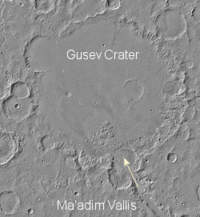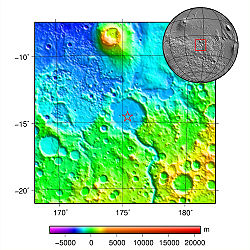Gusev Crater
The Gusev Crater was named in 1876 after Russian astronomer Matvei Gusev (1826–1866).[1] The crater (created by a large meteorite impact approximately 3.9 billion years ago during the Late Heavy Bombardment) is located 175.4°E 14.6°S, just south of the equator. Gusev Crater is in the Aeolis quadrangle. It is 144 km (90 mi) in diameter and provided an ideal landing zone for one of the MER rovers, Spirit. Spirit Rover landed at 14.5718 S and 175.4785 E on January 4, 2004.
Spirit rover discoveries
Spirit found the rocks on the plains of Gusev to be a type of basalt. They contain the minerals plagioclase, olivine, pyroxene, and magnetite. The rocks look like fine-grained basalt with irregular holes (geologists would say they have vesicles and vugs).[2] [3]
Much of the soil on the plains came from the breakdown of the local rocks. Fairly high levels of nickel were found in some soils; probably from meteorites.[4]
There is evidence that the rocks have been slightly altered by tiny amounts of water. Outside coatings and cracks inside the rocks suggest water deposited minerals, maybe bromine compounds. All the rocks are covered with a fine coating of dust. One type can be brushed off, while another needed to be ground off by the Rock Abrasion Tool (RAT).[5]
The dust in Gusev Crater is the same as dust all around the planet. All the dust was found to be magnetic. In addition, Spirit found the magnetism was due to the mineral magnetite, especially magnetite that contained the element titanium. One magnet was able to completely divert all dust hence all Martian dust is thought to be magnetic.[6] The spectra of the dust was similar to spectra of bright, low thermal inertia regions like Tharsis and Arabia that have been detected by orbiting satellites. A thin layer of dust, maybe less than one millimeter thick covers all surfaces..[7][8]
An ancient lake?
The crater exhibits evidence that it once contained substantial quantities of liquid water. A channel enters the south of the crater. Known as Ma'adim Vallis, this was almost certainly a means for which the crater was supplied with water. On January 9th, 2004, the Spirit rover landed in the crater and began to analyse the surrounding rock. Expecting to find overwhelming evidence of an ancient lake, mission scientists were disappointed to find very little indication of water.
Although this was unexpected, during the trip to the Columbia Hills, Spirit eventually found evidence that the area had once held a quantity of saltwater.[9][10]
References
- ↑ Matvey Matveyevich Gusev on Wikipedia
- ↑ Cite error: Invalid
<ref>tag; no text was provided for refs namedMcSween 2004 - ↑ Arvidson R. E. et al. (2004). "Localization and Physical Properties Experiments Conducted by Spirit at Gusev Crater". Science 305: 821–824. doi:. PMID 15297662. Bibcode: 2004Sci...305..821A.
- ↑ Gelbert R. et al. (2006). "The Alpha Particle X-ray Spectrometer (APXS): results from Gusev crater and calibration report". J. Geophys. Res. Planets 111.
- ↑ Christensen P (August 2004). "Initial Results from the Mini-TES Experiment in Gusev Crater from the Spirit Rover". Science 305: 837–842. doi:. PMID 15297667. Bibcode: 2004Sci...305..837C.
- ↑ Bertelsen, P., et al. 2004. "Magnetic Properties on the Mars Exploration Rover Spirit at Gusev Crater". Science: 305. 827–829
- ↑ Bell, J (ed.) The Martian Surface. 2008. Cambridge University Press. Template:ISBN
- ↑ Gelbert, R. et al. "Chemistry of Rocks and Soils in Gusev Crater from the Alpha Particle X-ray Spectrometer". Science: 305. 829-305
- ↑ Gusev Crater on Wikipedia
- ↑ NASA press release, May 21, 2007. Evidence for water in Gusev Crater








